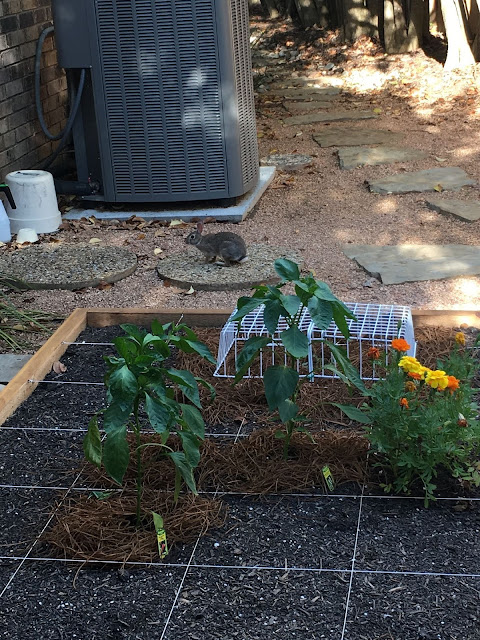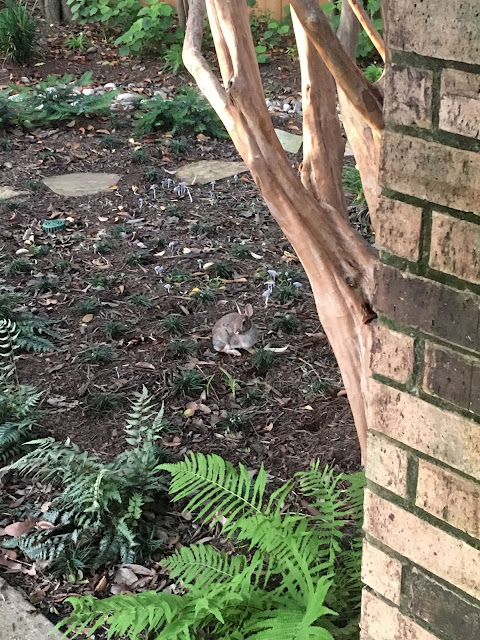New cantaloupe plants. After the rabbits (or something) ate the first two cantaloupe seedlings, I planted two more cantaloupe seeds. However, this time I covered the seedlings with an old metal wire shelf that we had lying around and not being used. It is actually two shelves zip tied together and fastened down with garden staples. The plan is to leave this in place until the plants are larger and hopefully less susceptible to rabbit attack. Presumably young seedlings and tender leafy plants such as lettuce will be of more interest to the rabbits than larger cantaloupe vines.
I still do not have definitive proof that it was the rabbits that ate the plants, but I certainly have lots of circumstantial evidence. One evening I went out after dinner to check on the plants and was nearly scared to death when a rabbit went running past me from the plants behind the bench. Yes, I am sure he may have been more scared than me, but he did not act like it. He stopped and turned around to look at me. His attitude was more that of "why are you here bothering me?".
The good news is that the new cantaloupe seeds germinated in only three days, so this has only set the cantaloupe harvest back about two weeks. Estimated time to maturity is 85 days or mid-Septemberish. Of course, that is assuming we get any harvest at all and I don't kill the plant in some way before then.
Pepper plants. The pepper plants are growing. Four of the five either currently have or have had blossoms. The banana pepper is growing the most, but has not yet made any blossoms.
The really exciting part is that one of the plants (Big Bertha) has two small baby peppers.
 |
| Baby bell peppers on Big Bertha plant |
Unfortunately, the Big Bertha plant is also the one that seems to be in distress and keeps dropping leaves. I don't know if it is from too much water, too little water, or heat issues. I hope I don't kill the plant before the peppers are usable.
Tomato class in Dallas. On Saturday we went to a Fall Tomato class at North Haven Gardens in Dallas. It is a long ways to go (near SMU), but NHG has beautiful plants chosen specifically for north Texas. They have a good selection of seeds and various accessories. Their staff is also knowledgeable and tolerant of my many questions.
I am glad I had done research ahead of time or I would have been totally lost in the class. As it was, I learned a lot and hopefully picked up some important tips on how to properly plant the tomato plants.
One of the things that I did learn was that the entire garden, not just the areas planted, should be mulched and kept watered. Otherwise the high temperatures from the sun will kill all of the important bacteria and other living components in the soil. It makes sense, but I had not considered it since to me dirt is dirt.
New tomato plants. Based on our research and the class, we bought four tomato plants which we planted this morning. The four tomato plants include three different varieties: Supersweet 100, Fourth of July, and Paul Robeson.
 |
| Four tomato plants behind two pepper plants |
All three varieties are indeterminate, i.e. vining as opposed to bush types. Indeterminate tomato plants can be grown in only one square foot each since they can be made to grow on the trellis. Bush or determinate varieties require nine square feet each.
Supersweet 100 are very sweet cherry tomatoes, what my tomato book calls "tomato candy", with an estimated maturity of 63-70 days. The Fourth of July plants produce small (4 oz) tomatoes, but reach maturity in only 49 days. If planted in the spring they mature by Independence Day, hence the name. The Paul Robeson plant will be an experiment. It is an heirloom variety (90 day maturity). Since it is an heirloom it is probably more susceptible to disease, but it apparently has a strong cult following among tomato experts due at least in part to its taste. I hope it survives, because it will be great to have some tomatoes that have more taste than what is sold in the grocery store.
I am not sure any of these maturity times take into account our hot summer temperatures. Most tomato plants will not set fruit until the temperatures are below 92 during the day and 75 at night.
 |
| Beginning to look more like a real garden |
Even if the tomatoes do not produce fruit any time soon, at least the garden is slowly taking shape and looking more and more like a real garden. The challenge for the next month will be to keep everything watered, but not over watered.
Next round of plantings. The tomatoes are the last of the plants to be transplanted. Everything else this year will be from seeds, all of which we got while at North Haven Gardens. These will be planted at various times, but the first big planting will be on August 1. On August 1, we will plant bush beans, wax bush beans, pole beans, zucchini, and broccoli.
Since all of the remaining plantings will be from seeds and hence produce little seedlings, I have to figure out how to protect them from the rabbits. Possibilities include more garden cages similar to what is over the cantaloupe or a fence around the entire garden. Both have advantages and disadvantages, so I am not sure how to proceed. Stay tuned.
















